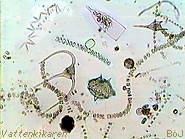It is difficult studying the
composition of the food that suspension feeders eat. It is not enough
to study what they catch, but we also have to deduce what part of
their catch they utilize. What is known is that suspension feeders
as a group utilize both living plankton organisms and dead organic
material. Certain suspension feeders are generalists and utilize most
types of suspended food, while others are more specialized and concentrate
on a certain type or size. Many sponges
and sea
squirts have very effective filters and can even feed on very
small organisms such as bacteria.
Another difficulty in determining which food is the
most important for suspension feeders is that they have the ability
to absorb molecules directly out of the water.
 Suspension feeders eat amongst others, small microscopic plankton,...
Suspension feeders eat amongst others, small microscopic plankton,...
| |
These organic molecules are
dissolved in the water and are a result of elements leaking from both
dead and living organisms. It is not known which specie have this
ability and to what extent. Finally, certain suspension feeders utlize
photosynthesis. Boring
sponges are such an example, by coexisting with single celled
algae they are able to utilize photosynthesis. This type of cooperation
is known as mutualism. The algae gain a protected place in
the light and an adequate source of food, while the sponge gains access
to certain organic molecules that the algae have produced.
<A HREF="havsr.mov">[Watch a dahlia anemone eat
1,1 MB]</A>
...but not even the large hermit
crab is safe from an attached creature like a dahlia
anemone .
|


